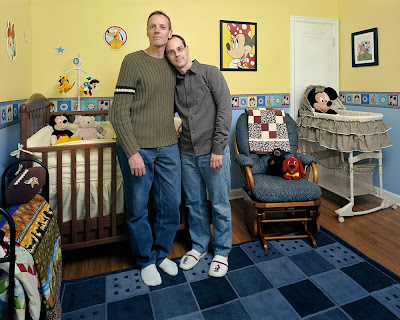Dona Schwartz
Looking at few of the portfolios that received Honorable Mentions for the Santa Fe Prize offered by Center and jurored by Maggie Blanchard of Twin Palms Publishing….
I’ve shared Dona Schwartz’s terrific project, In the Kitchen, in my classes for a number of years, so I was happy to see Dona receive an honorable mention for her new project, On the Nest. Dona’s work is about space and time; she examines the “interactions among and within the physical, social, and emotional spaces we inhabit”. She also recognizes the fleeting and evolving periods of childhood, parenting, and being part of a family. The image below, Christina and Mark, 14 months, from On the Nest was the Third Prize Winner in the 2011 Taylor Wessing Photographic Portrait Prize competition, awarded by the National Portrait Gallery, London.
Dona lives in Minneapolis, Minnesota. She earned her PhD at the Annenberg School for Communications is an artist, scholar, and educator. Amongst her many academic publications are two photographic ethnographies, Waucoma Twilight: Generations of the Farm (Smithsonian Institution Press, 1992) and Contesting the Super Bowl (Routledge, 1997). Her new photographic monograph, In the Kitchen, was published by Kehrer Verlag.
Her work has been internationally published and exhibited at venues including the National Portrait Gallery, London, Blue Sky Gallery, the Milwaukee Art Museum, The Stephen Bulger Gallery, the Pingyao International Photography Festival, and in numerous juried exhibitions in the United States. Her work is included in the collections of the Museum of Fine Arts, Houston, George Eastman House, the Musée de l’Elysée, Lausanne, Switzerland, the Harry Ransom Center, the Portland Art Museum, the Kinsey Institute, and the Museum of Contemporary Photography, Chicago’s Midwest Photographers Project.
ON THE NEST: In our lives we experience multiple transitions, and in these moments of change we renegotiate our sense of self. Events like communions, weddings, baby showers, and retirement parties formally mark the new roles and statuses we take on. We cross other thresholds without rituals or celebrations—even though divorce is a momentous life transition there is no script for marking its passage. I am intrigued by the ways in which we move from one life phase to the next, and I am working programmatically to represent complex processes of changing identity.
In On the Nest I use environmental portraiture to examine two moments of change that bookend parents’ lives—the transition to parenthood with a first child’s birth, and the transition to life without day-to-day responsibility for parenting when young adults leave their childhood homes. I photograph expectant parents in nurseries or other spaces they have made ready for their newborns, and I photograph empty nesters in the rooms left vacant by their grown children. The nursery is a canvas on which parents paint in broad strokes their imagined picture of the future. Creating the space is itself a celebratory ritual, and for many parents-to-be the nursery is a showplace—and a sacred space—to be shared.
Teenagers’ abandoned bedrooms tell different stories. The transition to life as an empty nester lacks formal ritual observance. There is no finite gestation period and the new beginning it heralds may be more sobering. In some vacated rooms, abandoned childhood toys compete for shelf space with high school trophies, providing a time-lapse history of nurturance, growth, and development. In others, boxes containing once treasured items await their final disposition. Unused beds become temporary worktables. A sewing room is born. By showing expectant parents alongside their empty nester counterparts I invite viewers to reflect on their own experiences of change and the trajectories we trace in the course of a lifetime.
Posts on Lenscratch may not be reproduced without the permission of the Lenscratch staff and the photographer.
Recommended
-
Earth Month Photographers on Photographers: Tyler Green in Conversation with Megan JacobsApril 15th, 2024
-
Luther Price: New Utopia and Light Fracture Presented by VSW PressApril 7th, 2024
-
Emilio Rojas: On Gloria Anzaldúa’s Borderlands: The New MestizaMarch 30th, 2024
-
Artists of Türkiye: Cansu YildiranMarch 29th, 2024
-
Artists of Türkiye: Sirkhane DarkroomMarch 26th, 2024











































































